Ugly Animals! 28 Ugliest Animals on Earth (Photos, Videos)
For most people, what constitutes “ugly animals” is relative. Creepy crawlies like snakes, beetles, and rats activate our “eww” reaction far more than other critters. There are some scary, ugly animals.
Some of the ugliest animals include the viperfish, naked mole rat, roseate spoonbill, shoebill, marabou stork, and human botfly. Red-lipped batfish, mata mata, snakefly, and babirusa are other ugly animals that made the list.
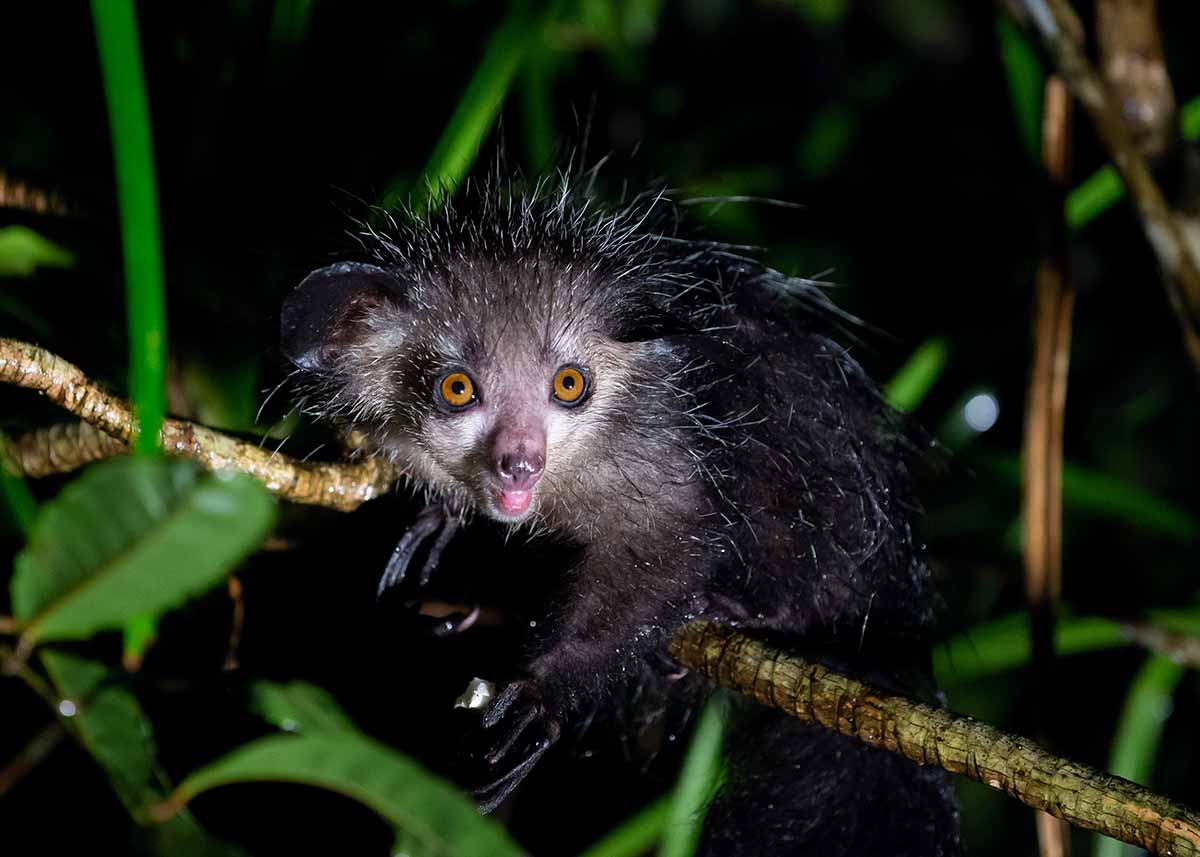
While self-reported fear of phobic animals is common, sometimes all it takes is a little knowledge to dispel those fears.
Ugly Animals Guide
While most animals are quite beautiful, even majestic, others are best described as ugly animals. This can be due to their appearance or even their gross behavior.
The following animals have unique features. To some, these features are cute. And to others, they are not that nice to look at. To me, I love to see them all. My favorite? I think the viperfish and mata mata are my favorite of these ugly animals.
Here is our list of ugly animals. Have one to add? Please mention it in the comments section below.
1. Roseate Spoonbill
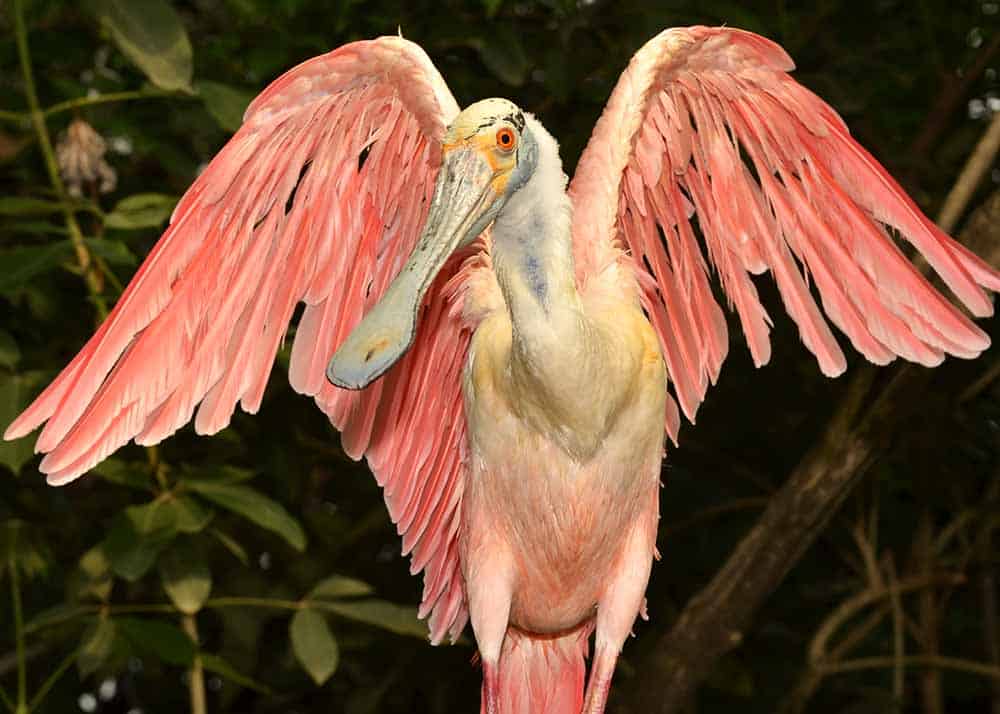
These awkward birds are found in the southern United States, from Florida to Texas. They have weird eyes, awkward body movements, and a spoon bill.
Think of an ugly flamingo, with a spoon bill.
2. Suriname Toad
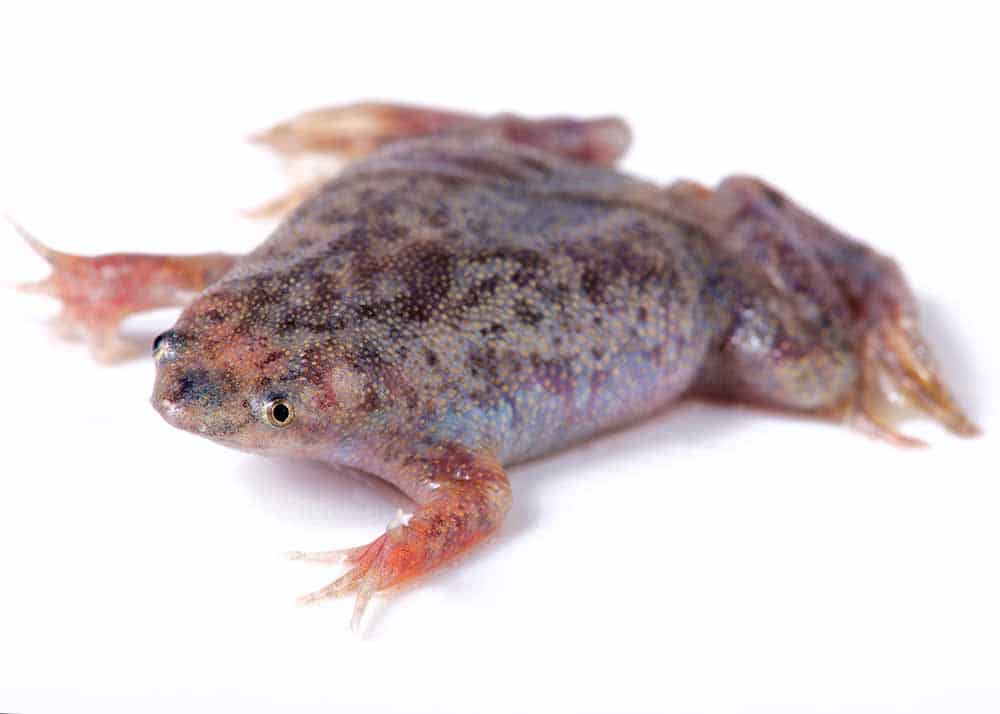
Hideous in appearance and habit, the Suriname toad (Pipa pipa) haunts South America’s freshwater swamps and lowland forests.
Worse than its soggy appearance, though, is how they mate. Rather than the more traditional methods, Suriname toads opt for implanting their eggs in pockets on the mother’s back.
These younglings stay put through the pollywog stage, using their tail to gather oxygen, before bursting forth as tiny versions of their parents after up to 20 weeks.
3. Naked Mole-Rat
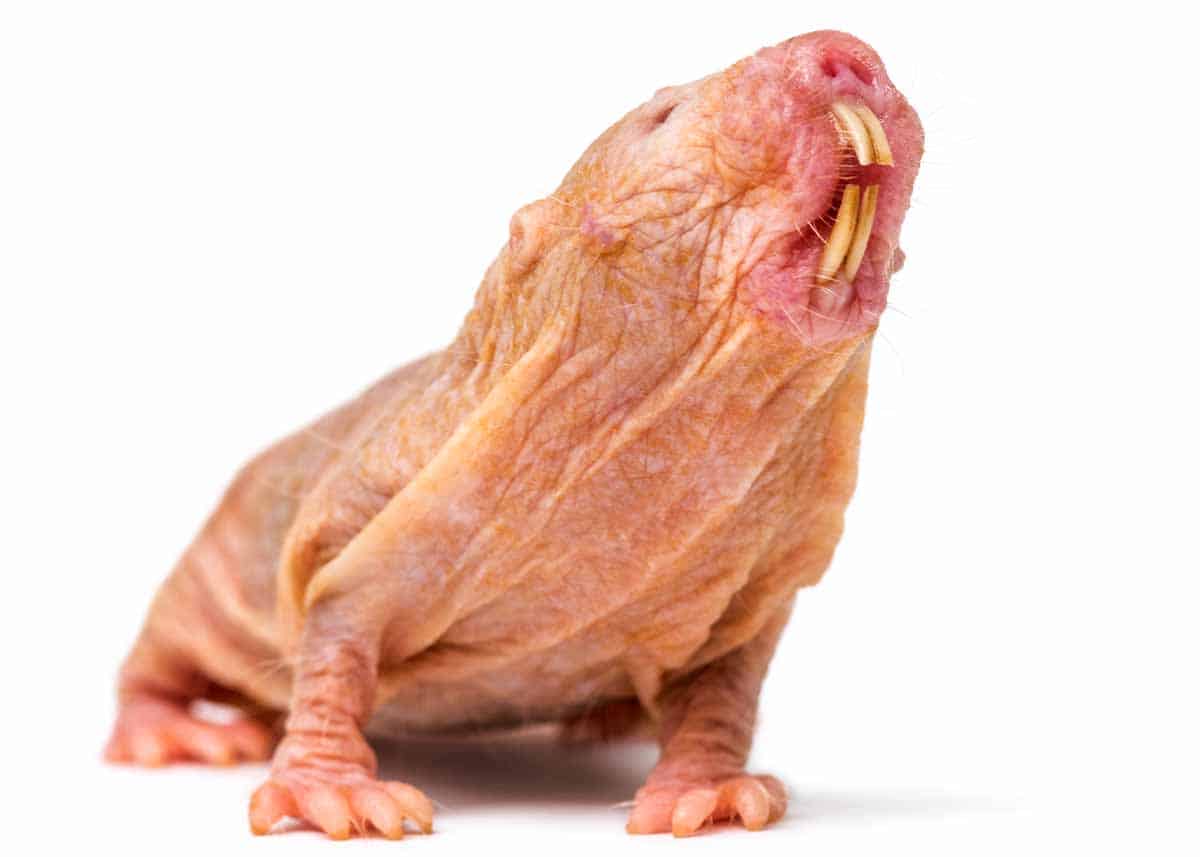
Hailing from subterranean burrows in eastern Africa, the naked mole-rat (Heterocephalus glaber) never outgrows that awkward baby phase like their other rodent relatives.
They come in a range of greyish-pink flesh tones, with nearly translucent undersides and tiny sensory whiskers that they use to feel around their tunnels. Their massive teeth help them chew through tough tubers and roots, which compose most of their diet.
Because they can’t regulate their internal temperatures, naked mole rats huddle in massive, fleshy groups.
4. Sarcastic Fringehead
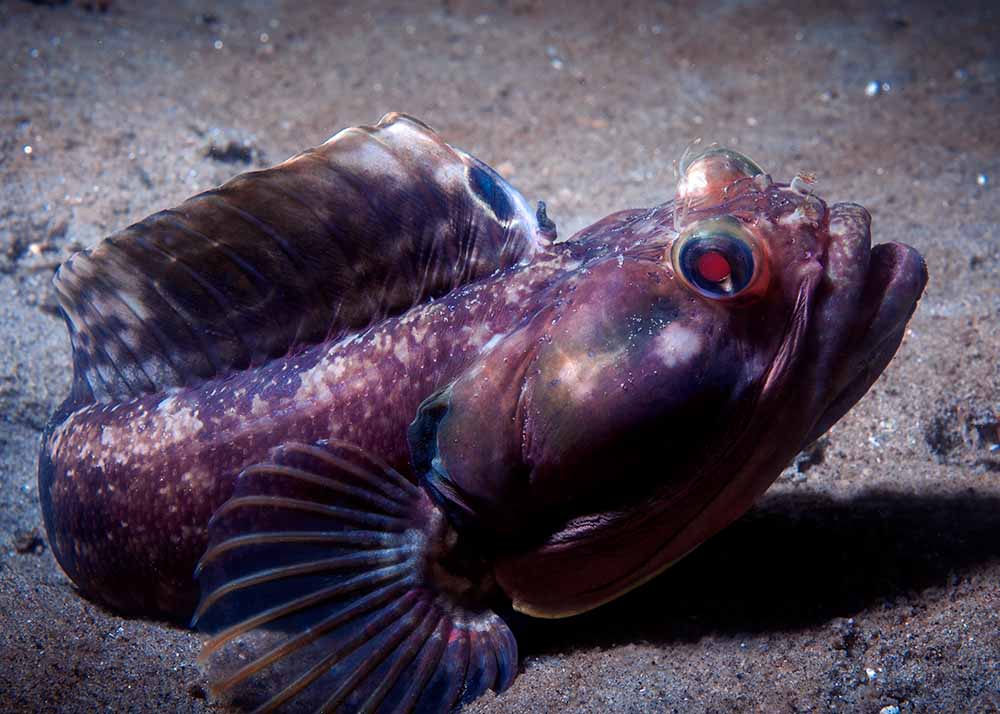
The ocean is full of fascinating creatures, balanced by the sheer variety of heart-quaking horrors that roam its depths. Enter the sarcastic fringehead (Neoclinus blanchardi).
This saltwater fish calls California’s Pacific coast home, where it indulges in fierce territorial battles with other males. Once engaged in the heat of war, it shows its true colors by distending its massive mouth and pressing against the mouth of its opponent.
Inside those cavernous chompers is a set of needle-like teeth, adding an extra layer of heckles-raising atrocity to an already ugly animal.
5. Viperfish
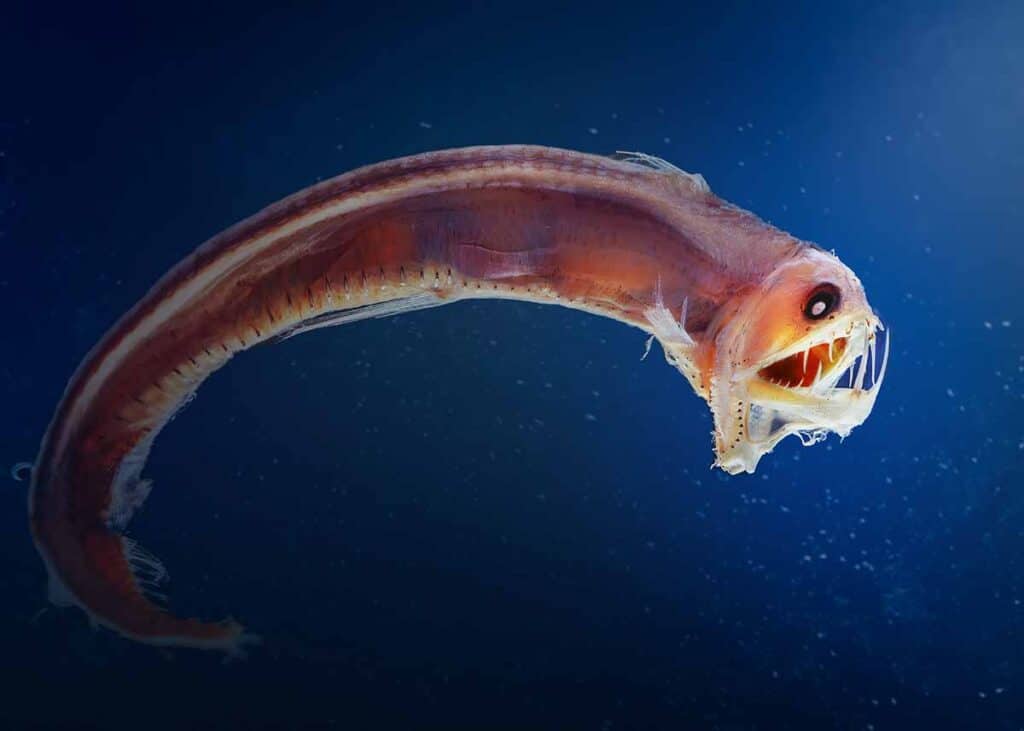
The Sloane viperfish (Chauliodus sloani) grows up to 12 inches in length. It comes in a variety of colors – black, green, or silver.
Because these are mostly deep-water fish (up to 9,000 feet), you’re unlikely to see them in the wild. They live in mostly tropical waters.
Here are some of the ugliest fish on the planet.
6. California Condor
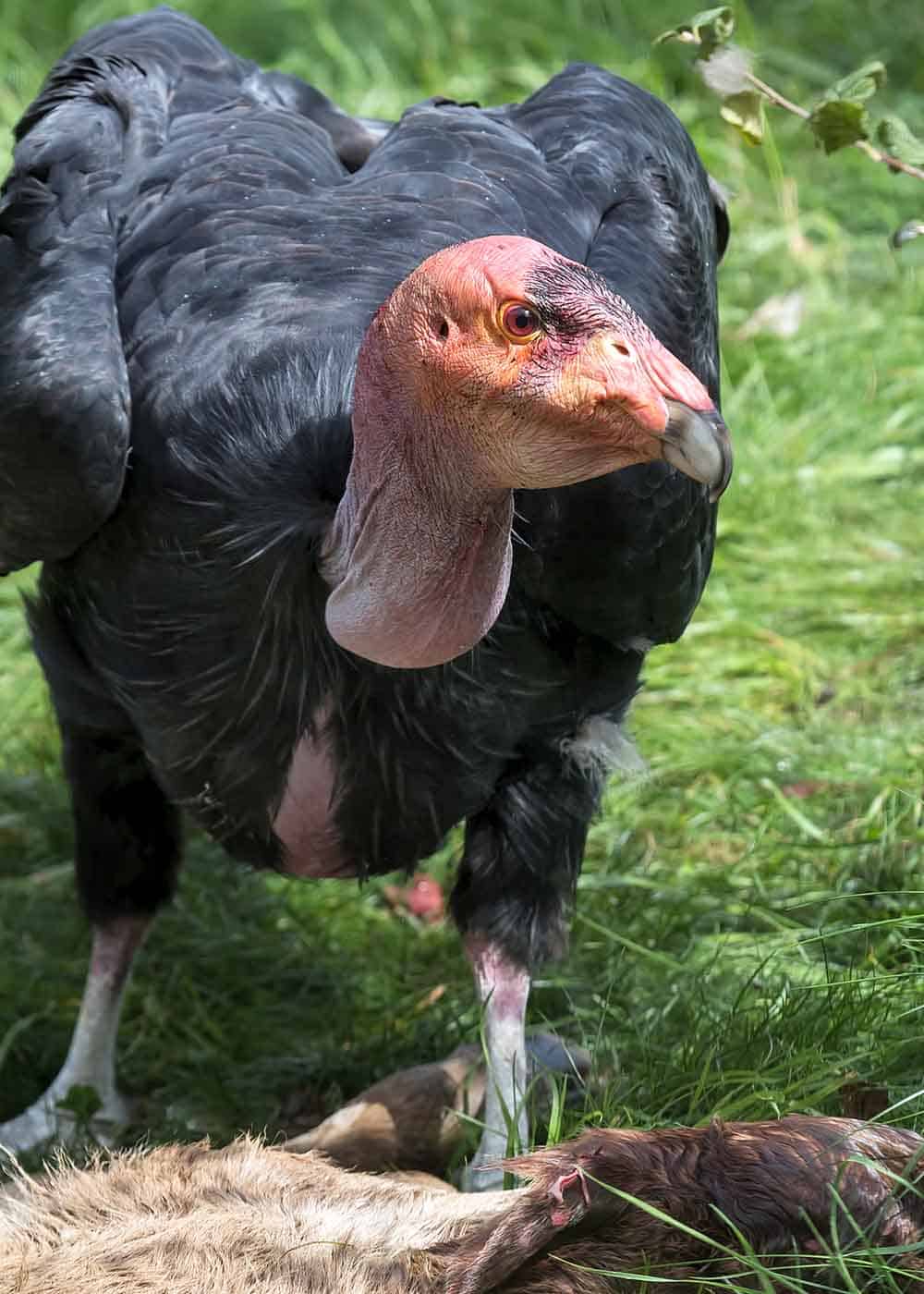
Carrion birds, like the California condor (Gymnogyps californianus), are symbols of death, rot, and danger. Still, these bald birds take it a step further when you find out those wrinkly, featherless noggins exist to make it easier to feast on decaying flesh.
They are the subject of extensive recovery efforts after nearly going extinct in the 1980s but have since found their niche in Arizona and Utah. Today, there are only 504 California condors in the world.
Here are more ugly birds to enjoy.
7. Saiga Antelope
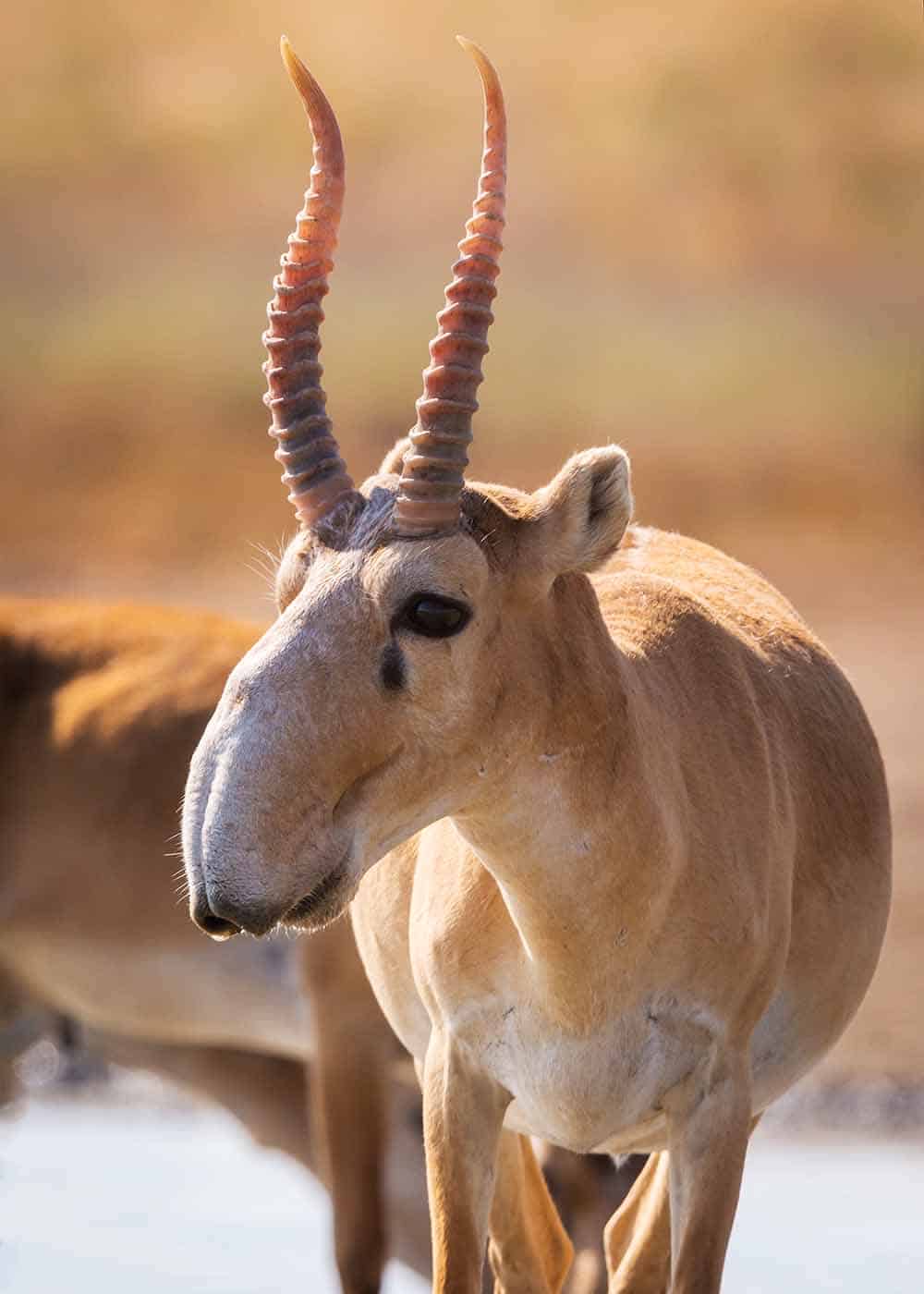
The Saiga antelope looks like the offspring of crossing an elephant with a deer. The not-quite-cute Saiga antelope (Saiga tatarica), a critically endangered species that once called the Carpathian and Caucasus Mountain foothills home.
There are only small tribes in Russia, Khazakstan, and Mongolia, where it uses its oversize, drooping nostrils to filter dust.
Learn more about all 74 types of antelope.
8. Vampire Fish (Payara)
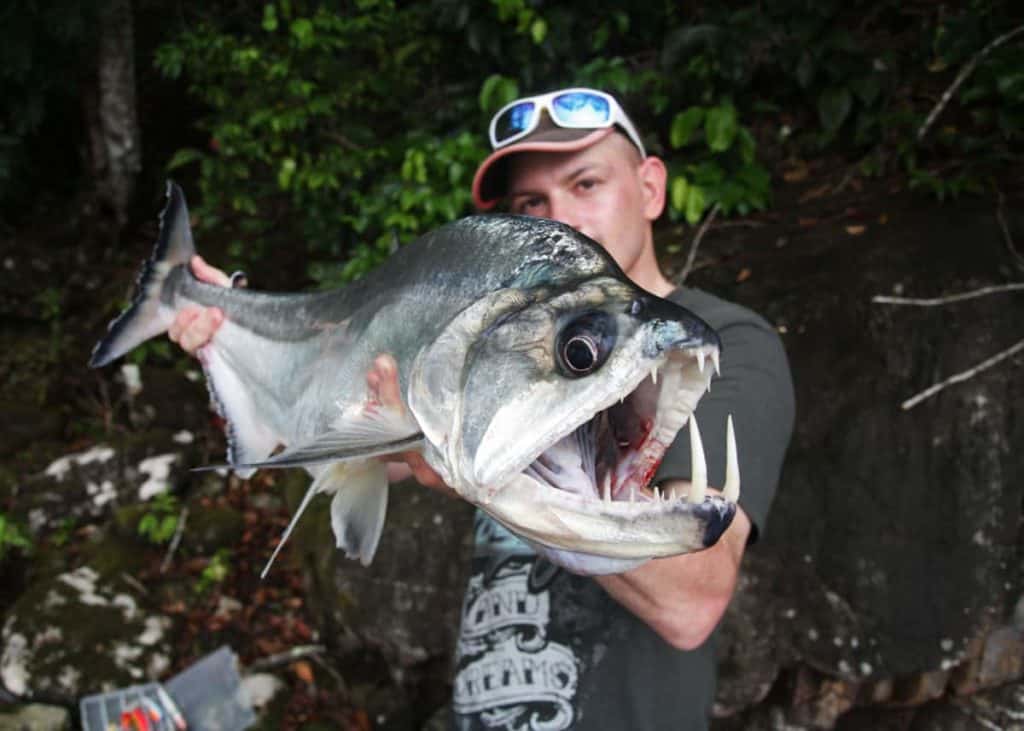
The payara fish (vampire fish) gets its name from the obvious giant fangs. The fangs can grow up to 6 inches in length and even protrude through the skull of the fish.
Its nicknames are “saber-toothed tiger fish” and “water wolf.” It literally eats piranhas for breakfast.
Learn more about common rainforest animals.
9. Shoebill
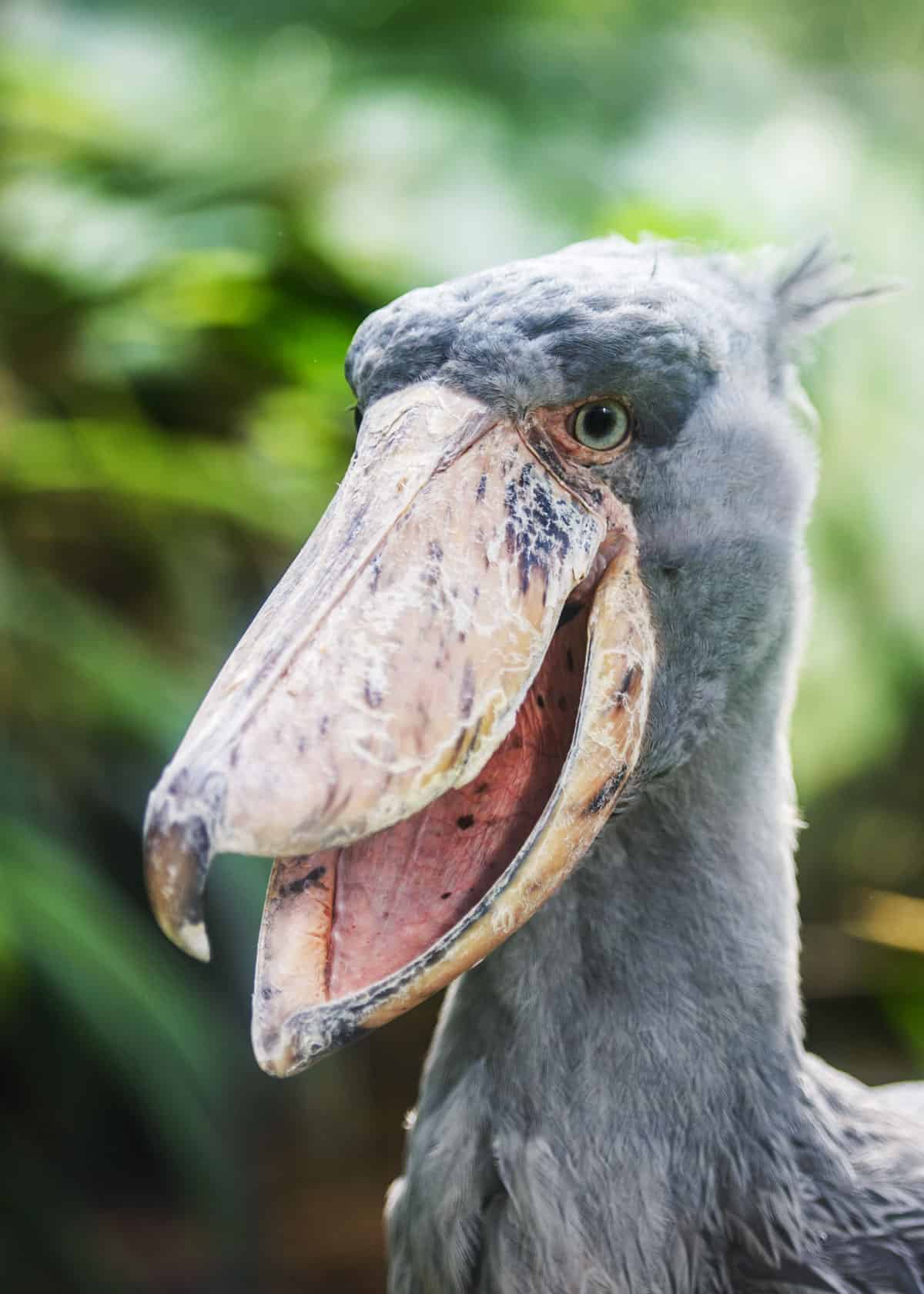
When Alfred Hitchcock was cooking up the villains for his 1963 classic thriller The Birds, he may have left out the shoebill (Balaeniceps rex) because it would have been far too traumatizing for theater audiences.
Standing up to five feet tall on long, spindly legs, these stork-like birds dwell in African swamps, putting their bulbous bills to good use, snapping up lungfish, tilapia, water snakes, frogs, and baby crocodiles.
Here are more ugly African animals.
10. Human botfly
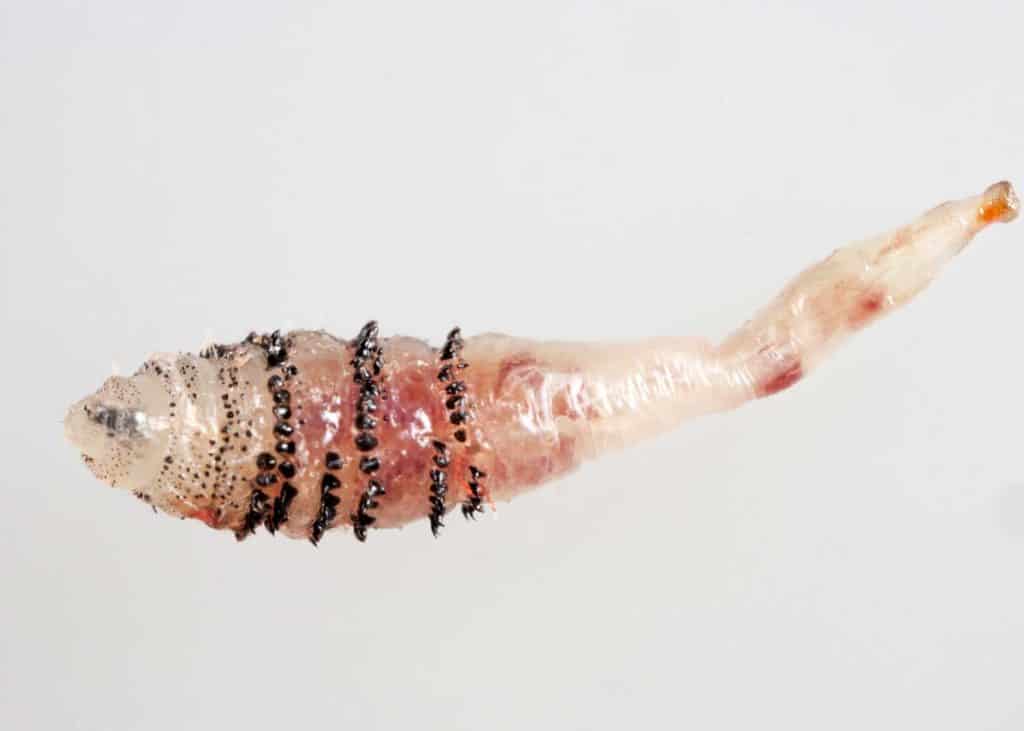
At first glance, there is no debating the ugliness of this little animal. And you’ll probably be disgusted to know that these larvae will burrow into the skin of mammals – including humans – and feed on their flesh.
You can find Dermatobia hominis in Central and South America.
Love animals? Check out our huge set of animal content.
11. Scorpionfly
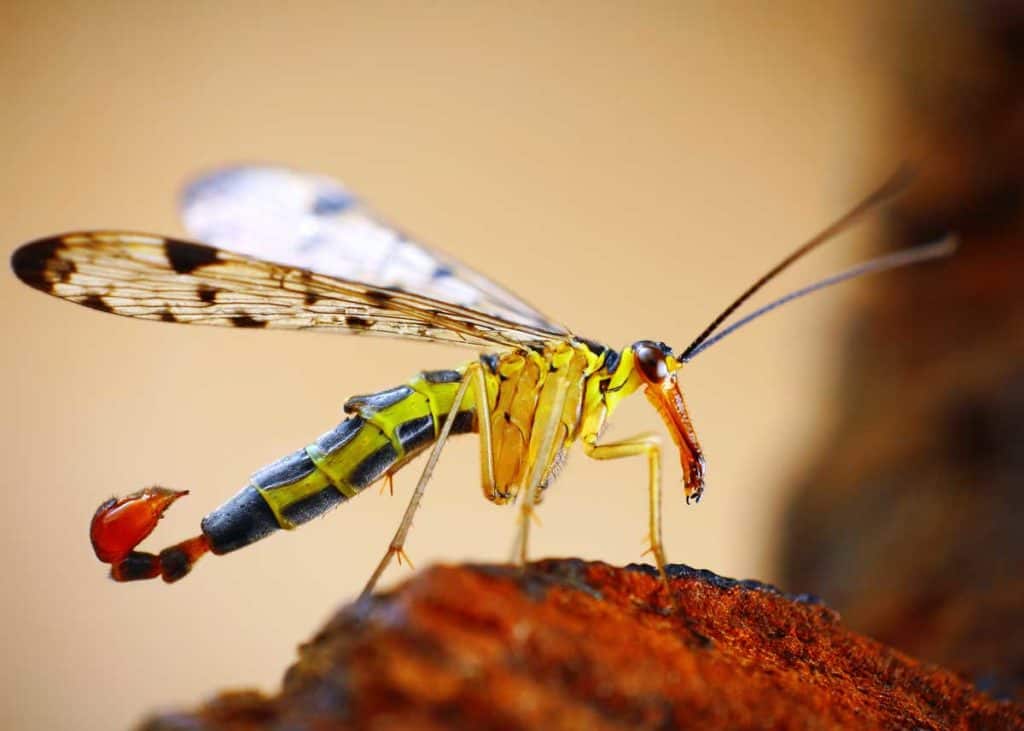
The scorpionfly (Panorpa communis) spends its days in European and North Asian forests, using its massive, serrated mandibles to saw through the exoskeletons of insect corpses to get to the soft innards.
The scorpionfly gets its name from the stinger-like backside exclusive to males. This isn’t actually a stinger but a clamp used to hold down females while mating.
12. Chinese Crested Hairless Dog
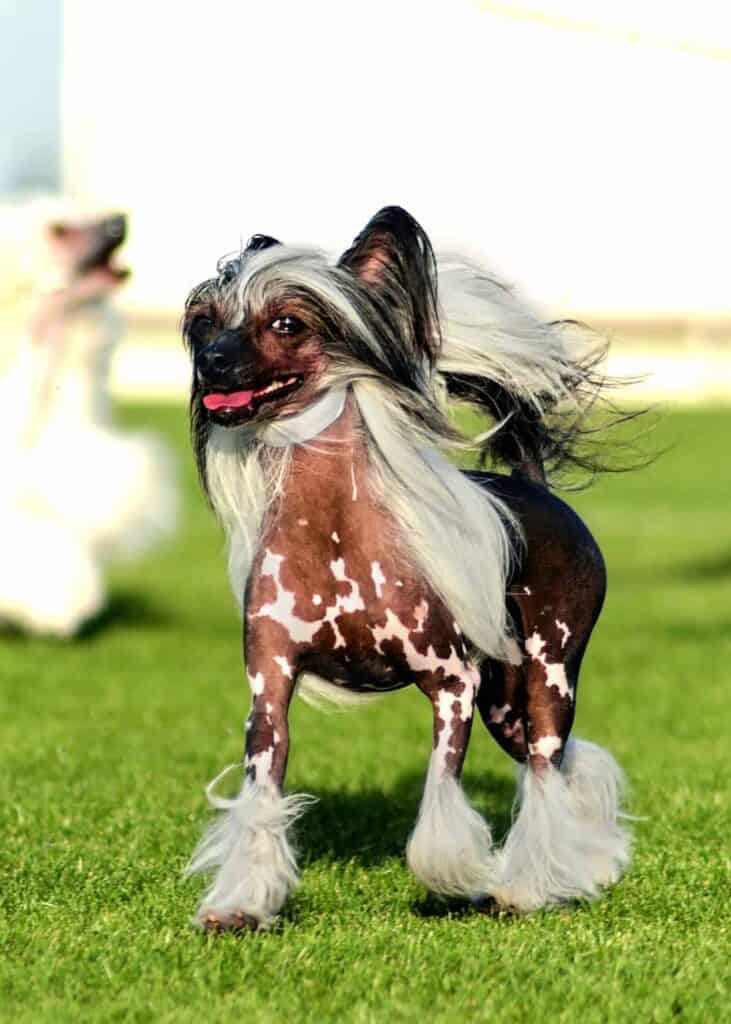
When it comes to man’s best friend, the Chinese Crested Dog (Canis lupus familiaris) ranks in the “so ugly, they’re cute” category, thanks to their appearance resembling that of a naked mole rat.
This breed sports an odd fur pattern, with the hairy-hairless variety having furry feet, a plume-like tail, and a crest of hair on its head. The proper hairless type is bald from head to toe.
13. Komodo Dragon
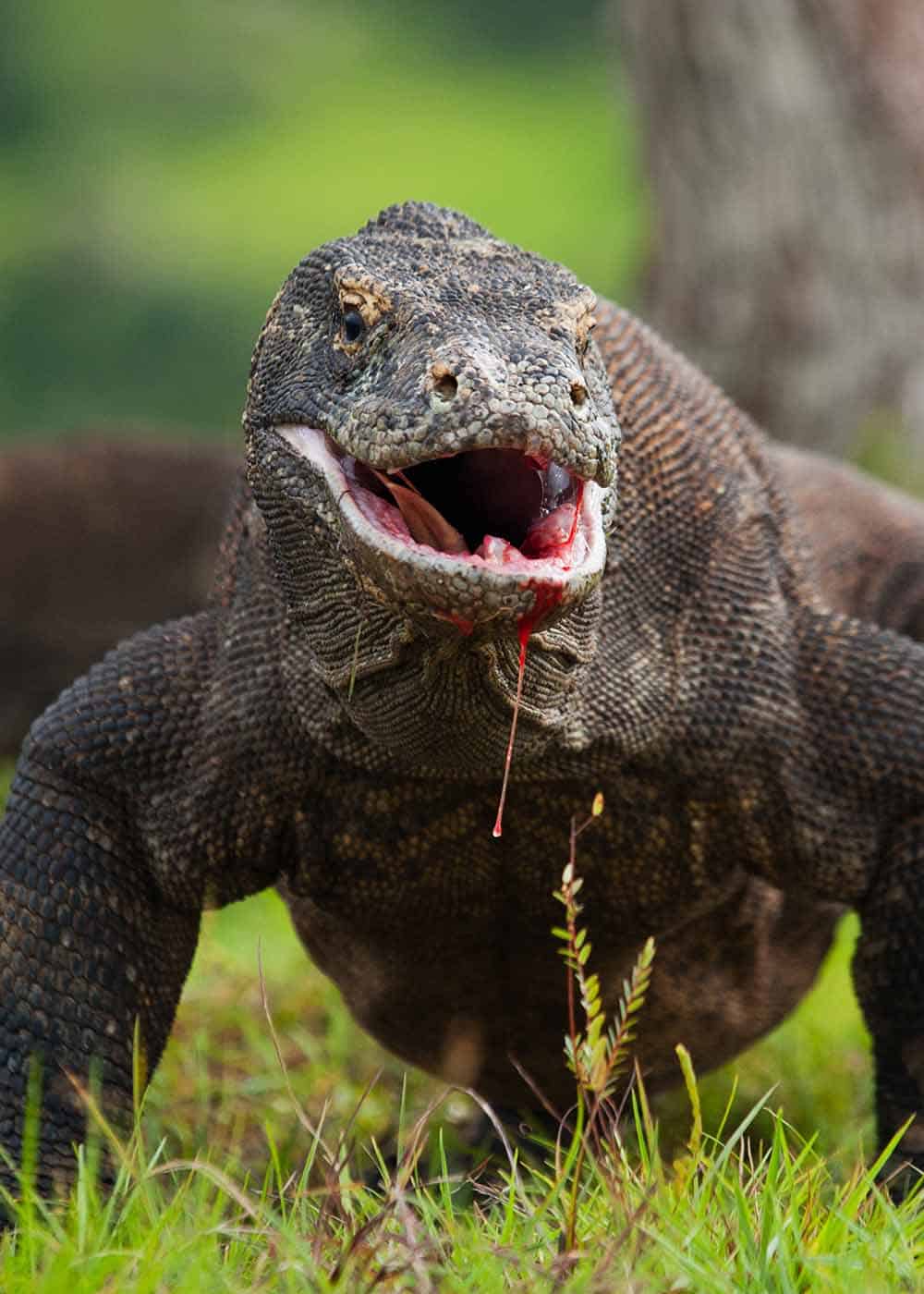
Prowling the islands of Indonesia, the Komodo dragon (Varanus komodoensis) is a hulking, scaly monster that can reach a terrifying ten feet in length and tips the scales at 150 pounds.
Despite hauling around all that muscle, Komodos dominate their niche thanks to venom glands in their mouths that also feature an anti-coagulant to ensure their prey bleeds out if they don’t succumb to the toxins first.
14. Northern Elephant Seals
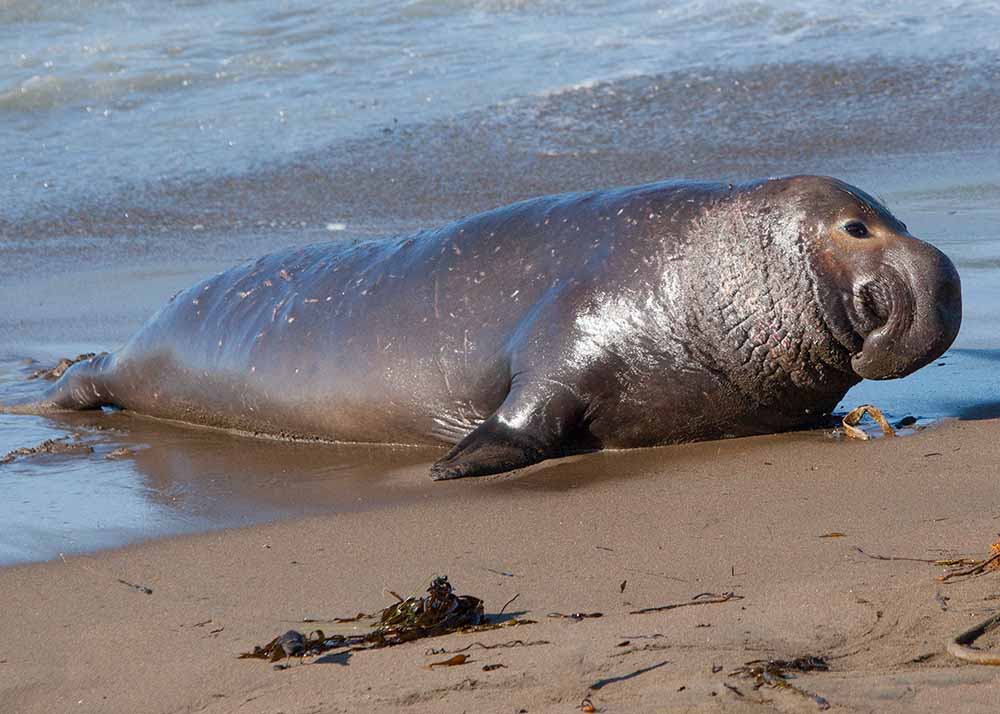
Bulbous, bloated, and boisterous northern elephant seals (Mirounga angustirostris) are one dinner guest even the most hospitable host would loathe having around.
While they’re pretty cute as pups, these massive carnivores spend their adulthoods on the shores of the eastern Pacific packing on up to 8,200 pounds of pure blubber and honing their distinctive honking call through their flapping proboscis.
15. Vampire Bat
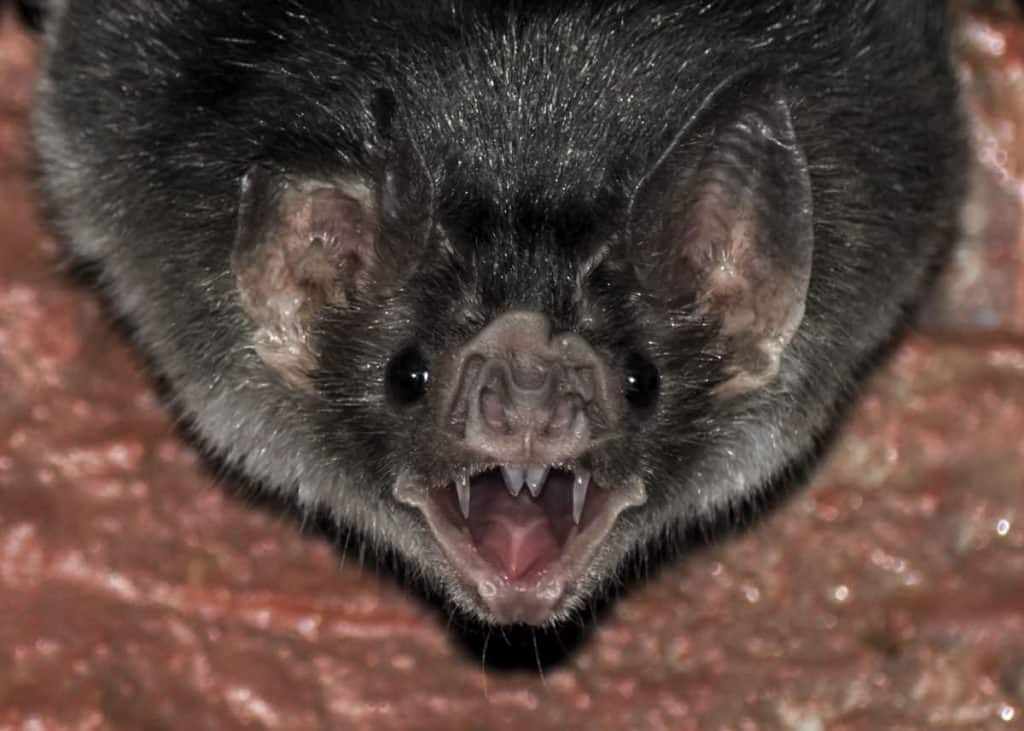
The common vampire bat can be found in the Amazon rainforest region. They can be seen from Mexico to Argentina.
All 3 species (common, white-winged, and hairy-legged) have heat sensors and feed only on blood. Despite their scary appearance, they are quite small – just 3 inches long.
16. Star-Nosed Mole
Moles are hardly the stuff of legends unless you’re an avid lawn care expert. These rather plump, blind fellows wile away their days shuffling through the soil, barely bothering a soul.
Then, there’s the star-nosed mole (Condylura cristata), a North American native with a tentacle-like nasal appendage. This slimy adaptation wiggles and reaches, alerting the owner to any insect snacks the creature is otherwise blind to.
17. Marabou Stork
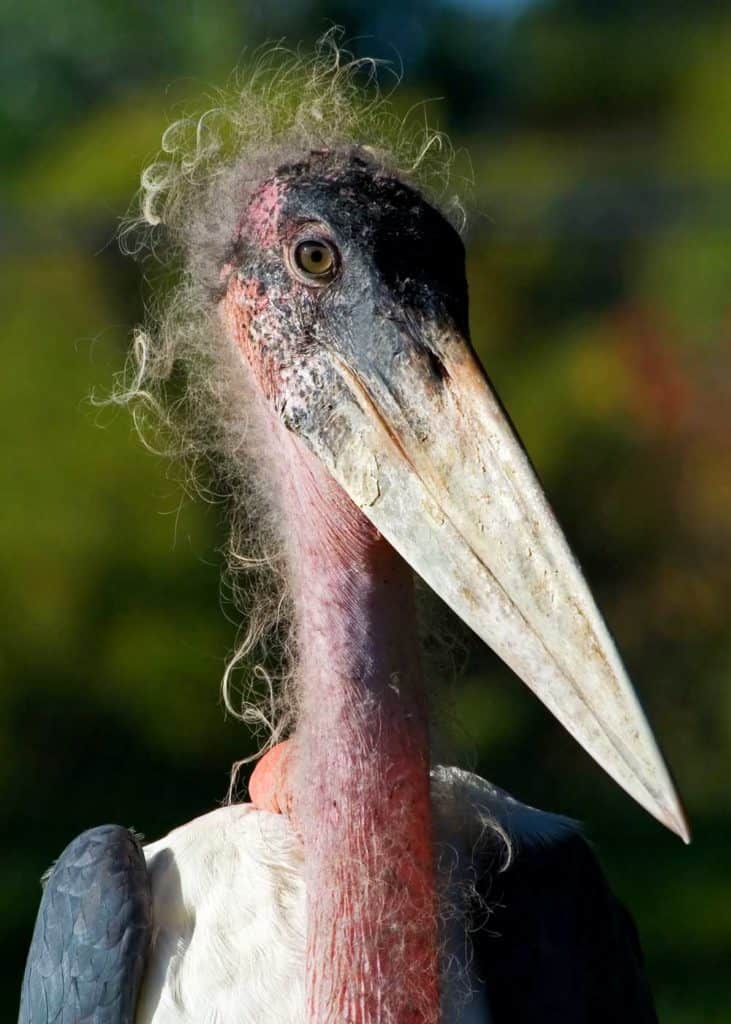
The marabou stork is 5 feet tall and has an 11-foot wingspan. It has a bald head, hairy neck, and what appears to be an undertaker’s cloak.
They have been known to hunt small animals as they flee grass fires. And they will squirt excrement on their legs to cool themselves from the hot sun.
18. Red-Lipped Batfish
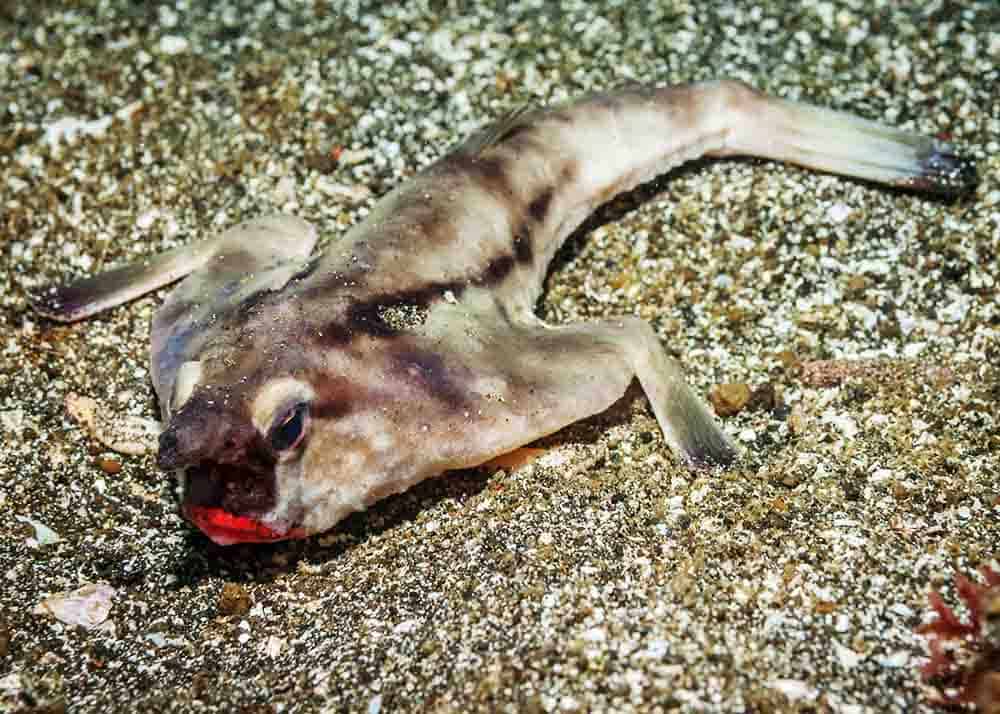
Like a lady dressed up with nowhere to go, the red-lipped or Galapagos batfish (Ogcocephalus darwini) sports a scarlet pucker that looks rather garish compared to the rest of its monotone coloration.
As if that weren’t off-putting enough, this fish prefers to stroll along the sandy depths off the coast of Peru and the Galapagos Islands, using its anal fins as improvised walking apparatus.
Finishing off this grotesque image is a large “horn” protruding from its forehead, making it the world’s ugliest animal that could technically be called a unicorn.
19. Mata Mata
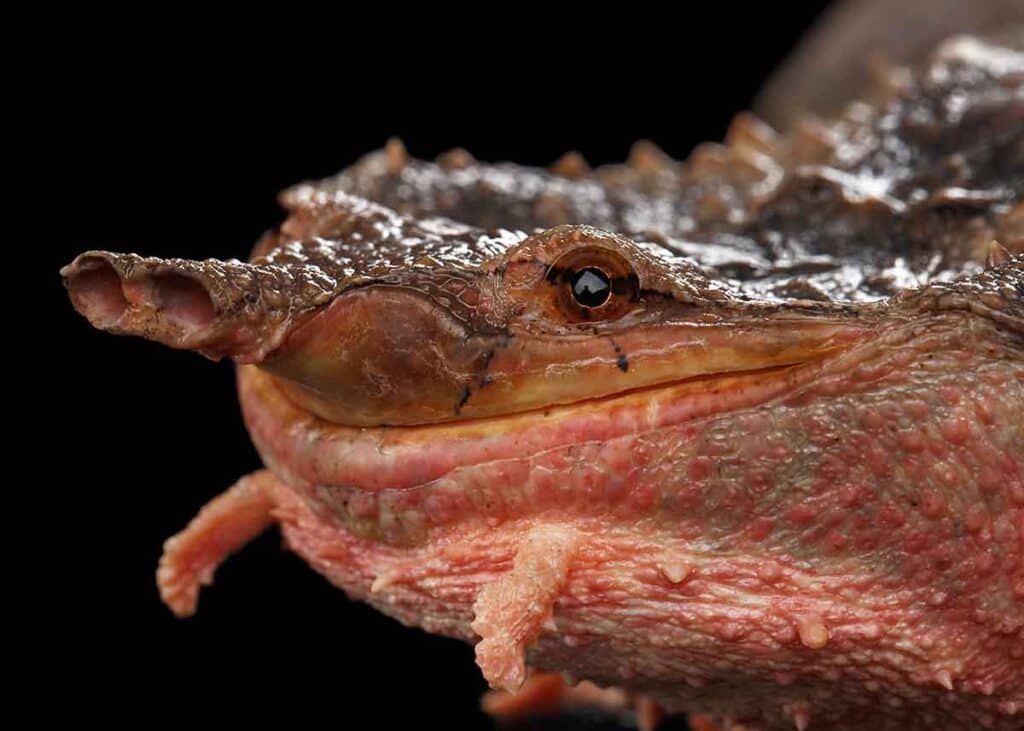
The mata mata turtle (Chelus fimbriata) of the Amazon rainforest has a very unique appearance.
Mata matas are hide-and-seek champions thanks to their flaps of loose skin and weird body-covering warts that help them resemble a fallen piece of tree bark as it lounges in vegetation-choked, slow-moving streams.
20. Buru Babirusa
Warthogs avoid their spot amongst the ugliest animals and owe it all to the offputting Indonesian-island dwelling Buru babirusa (Babyrousa babyrussa).
Also known as the pig deer, this wild hog has two sets of hardcore tusks, one growing upwards through the nose before curving up towards the forehead.
While these tusks look ferocious, they break quite easily and aren’t a helpful weapon for territory combat.
21. Gharial
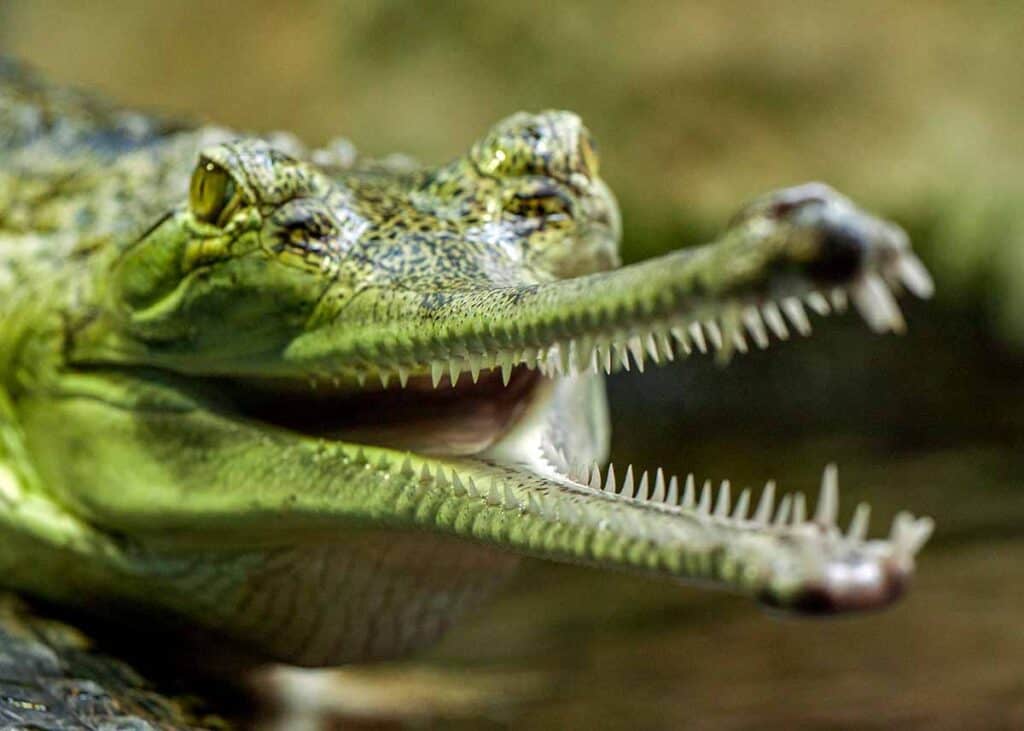
Like some science experiment gone wrong, India’s gharial (Gavialis gangeticus) resembles a hybrid between a crocodile and a garfish due to its extra-long snout packed to the brim with 110 flesh-annihilating teeth.
Males can reach lengths of up to 19 feet, 8 inches, and have a distinctive hollow growth on the ends of their nose that resembles a ghara cooking pot, hence the name.
22. Damascus Goats
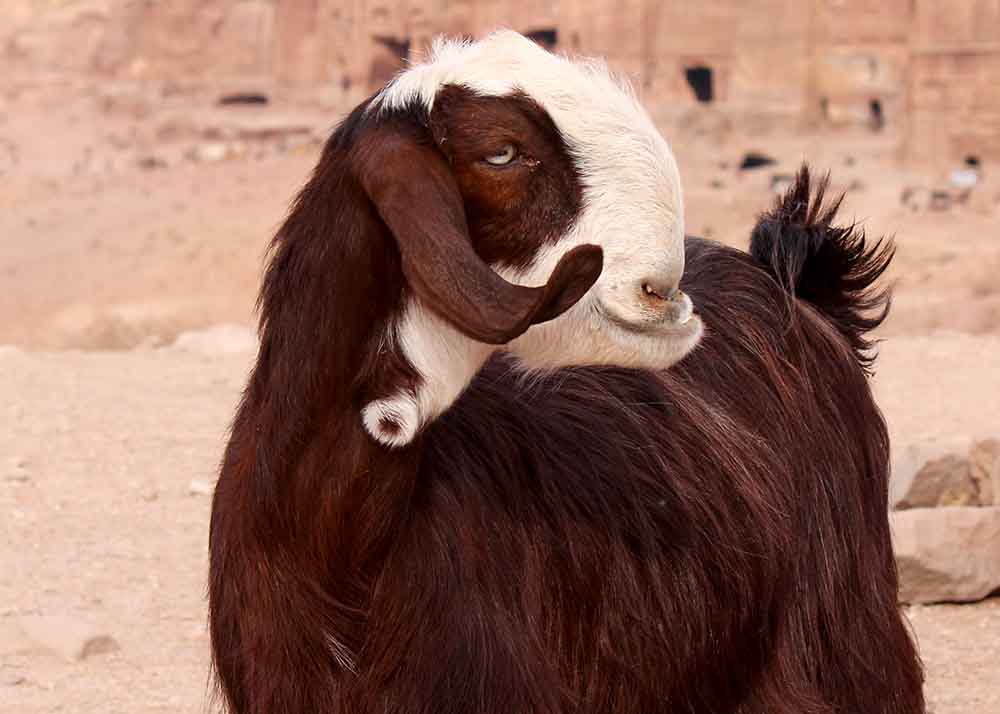
The Damascus goat (Capra aegagrus hircus) is a Middle Eastern breed that has a flat-nosed visage. They are precious in their home countries for milk and wool, resulting from a long history of genetic selection.
23. Titicaca Frog
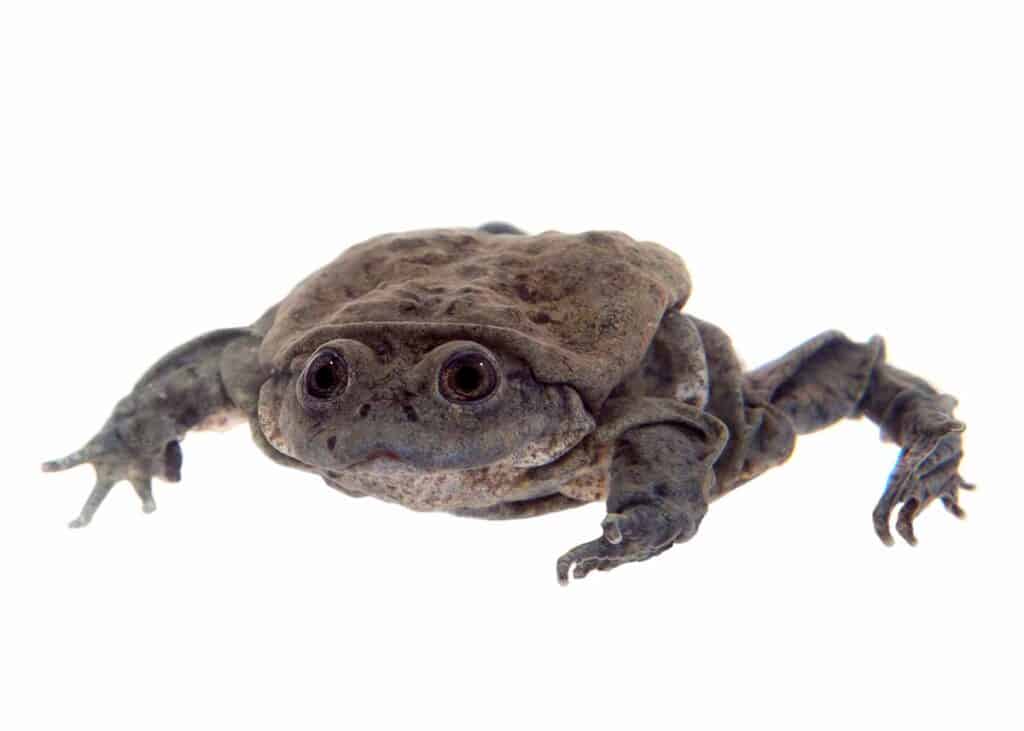
The Titicaca frog (Telmatobius culeus) is endemic to Lake Titicaca in the Andes Mountains. They’re rather large amongst their amphibious kin, reaching sizes of up to 2.2 pounds.
At first glance, it seems perfectly normal, perhaps even cute. Upon closer inspection, though, its overlapping skin flaps look rather baggy and bloated as they float in the water.
24. Ocean Sunfish
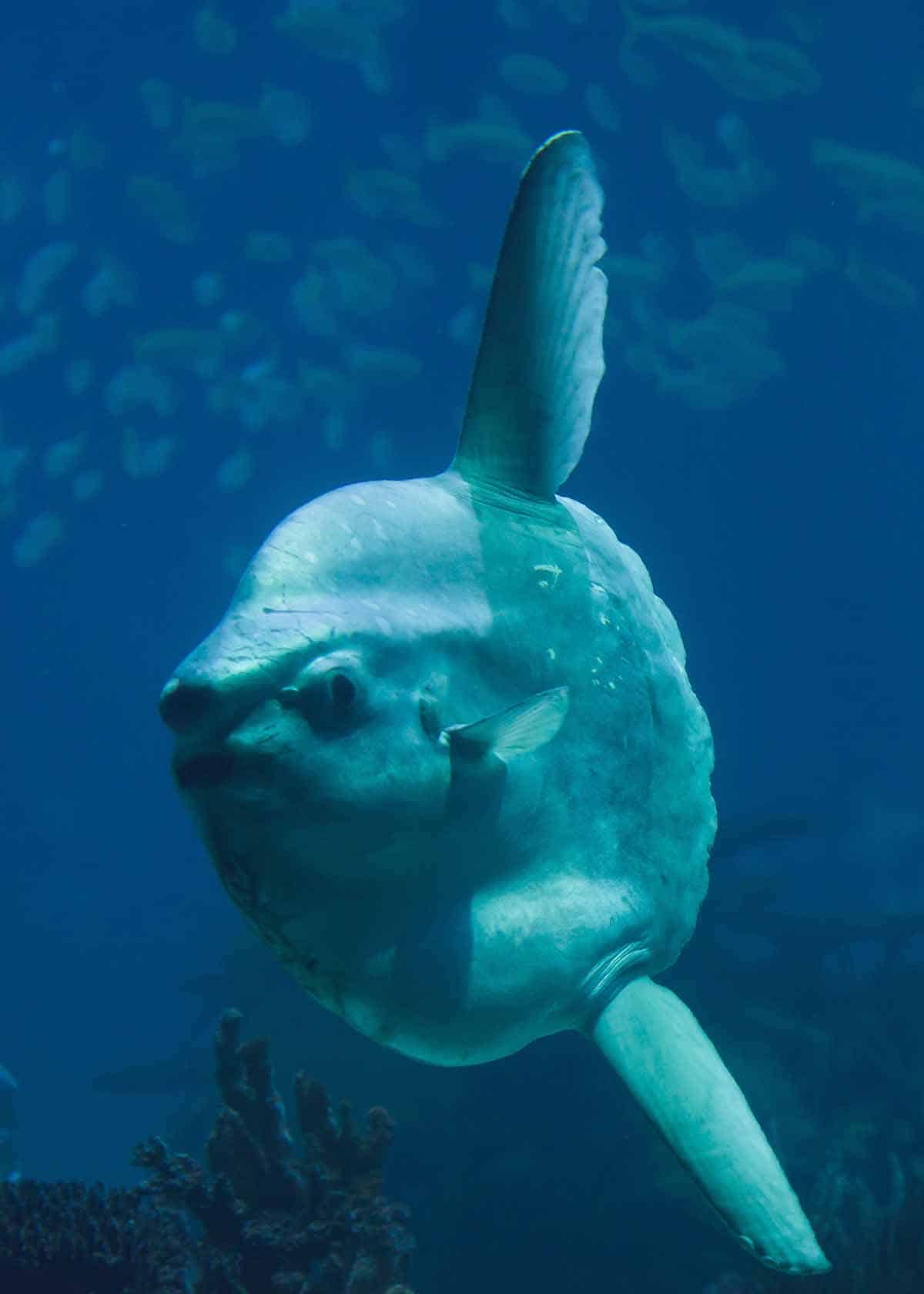
When it comes to the ocean, bigger is better, at least in the case of the sunfish (Mola mola). This massive native of tropical waters tips the scales at more than 5,000 pounds and holds the rank of the second-largest bony fish.
The flattened disk of a fish is unique and special to see in the wild. It has large, fleshy lips, tiny fins, and a beak of fused teeth. These features give it a constant dumb-founded expression.
25. Hairy Frog
The hairy frog (Trichobatrachus robustus) lives in the moist forests of tropical and subtropical Africa and is enjoyed by many herpetologists.
This abysmal amphibian’s nicknames include horror frog and Wolverine frog. In addition to the male’s ability to grow a shag rug of artery-sporting appendages along its sides and thighs– hence the “hairy” moniker– it also possesses a unique defense mechanism.
Like the Marvel comic book character Wolverine, a threatened hairy frog breaks its own toe bones to unsheath sharp claws on its back feet that break through their skin on the way out.
26. Giant Wētā
There are 11 species of Giant Weta in the genus Deinacrida. They can be as large as a gerbil.
Their genus name Deinacrida literally means “wrinkled, terrible grasshopper” and provides an excellent hint for what you’re in for should you find yourself wandering through New Zealand.
This nocturnal insect is one of the largest in the world, reaching lengths of up to 4 inches – not including the legs or antennae.
Some individual weta have weighed in at 2.4 oz (70 grams), making it one of the heaviest insects in the world. And heavier than a sparrow.
27. Agulla Snakefly
Buzzing through the western United States airwaves is the snakefly (Agulla), a genus in the larger Raphidiidae family that won Arizona State University’s ugliest bug award in 2009 alongside competitors that included the dreaded cockroach.
What about the snakefly makes it so unsightly amongst a sea of other ugly animals? Voters cited its elongated neck, snake-like head, and slithery body as its most horrible traits.
See more ugly insects.
28. Aye-Aye
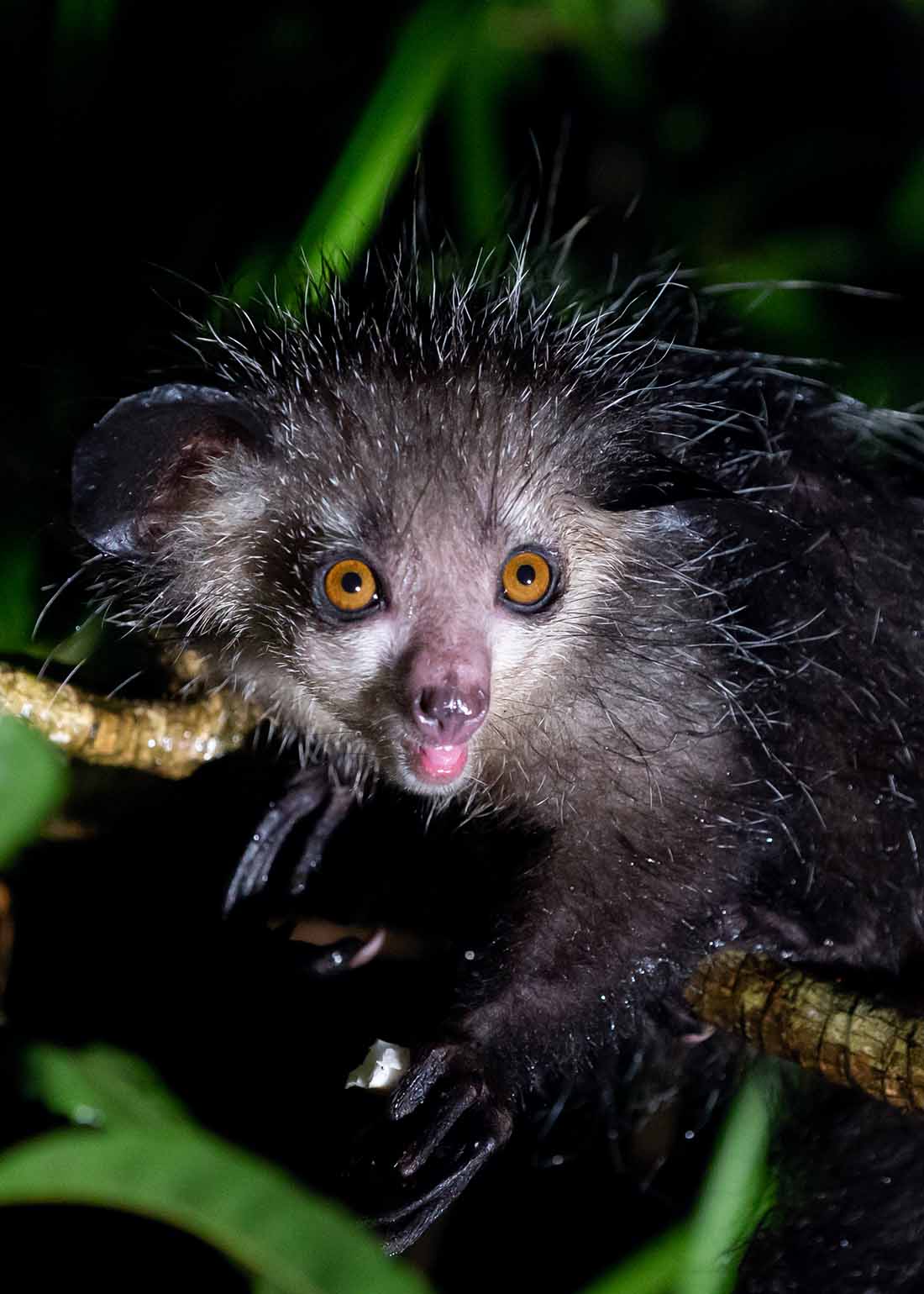
Rounding out our list of ugly animals is the Madagascar Island aye-aye (Daubentonia madagascariensis), a lemur species with creepy fingers that seem inspired by extraterrestrials and unblinking yellow eyes.
Its scruffed, patchy coat does little to help its appearance, making the creature look like a rabid beast rather than a gentle, nocturnal tree dweller that happily shares its nests with other passing primates.
Your Turn
Ugly animals often take a backseat in a world obsessed with pandas and puppies. It’s a phenomenon so prevalent that scientists are actively looking for ways to remove the stigma and move research into these fascinating creatures forward.
While they’re certainly not as easy to love as other typical cuties, they still offer much in their ecosystems and the greater zoological community.
Have one to add? Or maybe disagree with one of my choices? Let me know below!





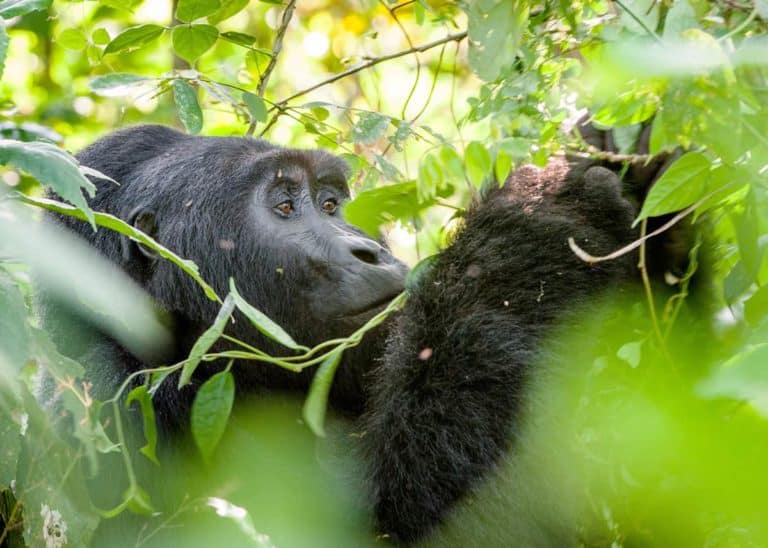
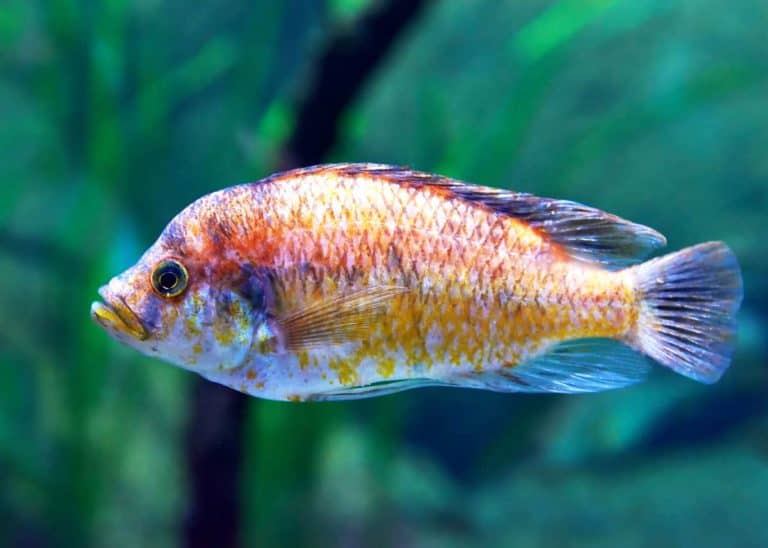
Excellent documentary. A most interesting, and enjoyable read. Thank You. Miryana from a coastal fishing town out of Sydney.